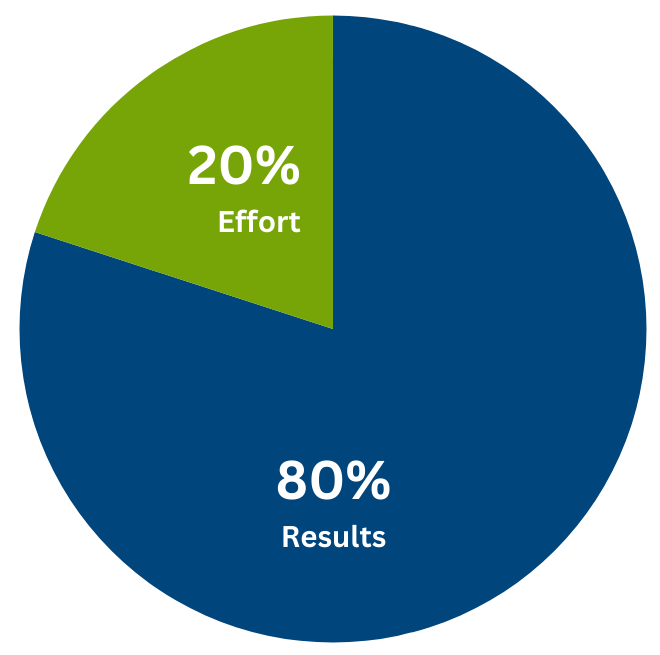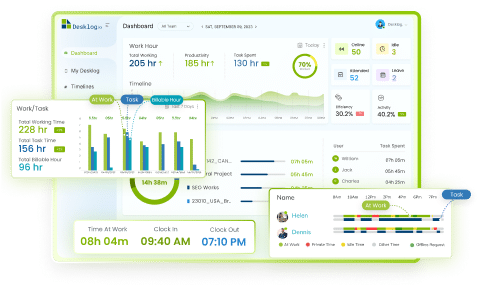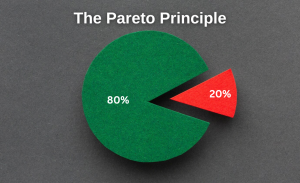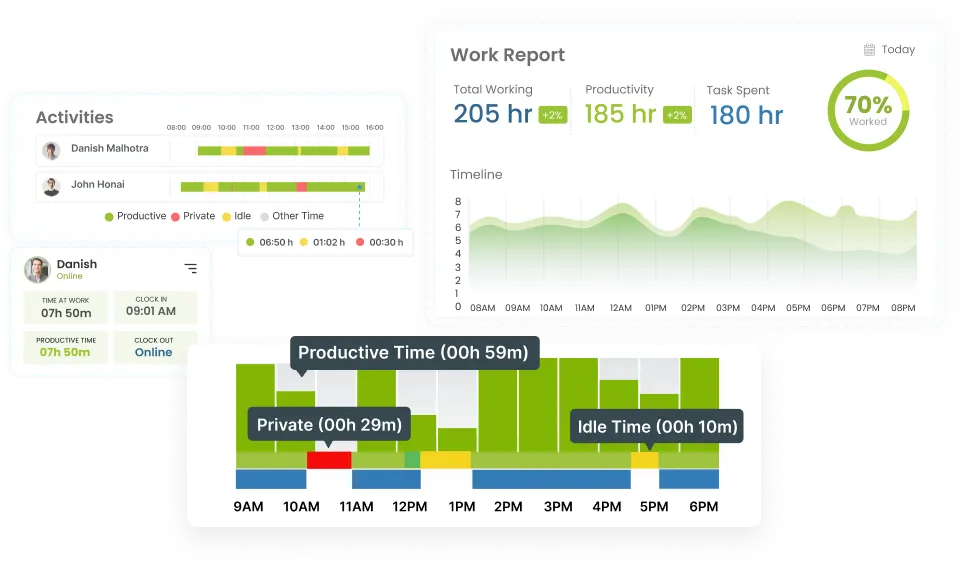What if I told you that it’s possible to enjoy personal time and relaxation while still excelling in your 8-hour workday? It might sound like a challenge, but it’s absolutely achievable. The secret lies in a technique called the Pareto Principle, or the 80/20 rule.
Have you ever heard of it? If not, don’t worry this blog will help you understand the concept and explore how it can significantly improve your daily life and work-life balance.
So, rather than feeling overwhelmed by a never-ending to-do list, you can use this principle to work smarter, not harder, and create more room for relaxation and personal time without sacrificing success at work.
In the following sections, we’ll dive deeper into how the Pareto Principle works and how you can apply it to take control of your day, achieve your goals more efficiently, and still have plenty of time left to unwind.
What is the Pareto Principle?
The Pareto Principle, also known as the 80/20 Rule, is a concept that illustrates how a small portion of causes often leads to the majority of effects. It states that 80% of results typically come from 20% of the effort or causes.

This principle highlights the disproportionate relationship between inputs and outputs, suggesting that a few factors are responsible for the majority of outcomes. While it’s a useful framework, it is not a strict mathematical law but rather an observation that can be applied in various areas, including economics, business, and time management.
Origins of the Pareto Principle

The principle was first observed by Vilfredo Pareto, an Italian economist, in the late 19th century. Pareto discovered that 80% of the land in Italy was owned by only 20% of the population.
He also noticed a similar pattern in his own garden, where a small portion of his plants produced most of the fruit. Pareto’s observations led to the formulation of the 80/20 Rule, which has since been applied to a broad range of fields.
How the Pareto Principle Works?
The 80/20 Rule suggests that a minority of causes, inputs, or efforts (the 20%) contribute to a majority of the effects, outputs, or results (the 80%). This imbalance can be observed in various scenarios:

In business, 20% of customers may account for 80% of a company’s revenue.

In time management, focusing on the most important 20% of tasks can produce 80% of your results.

In sales, 20% of products may generate 80% of sales.
Applications of the Pareto Principle
The Pareto Principle can be applied to many areas to help prioritize efforts and increase efficiency:

Business and Marketing: By identifying the key 20% of customers or products that contribute most to revenue, companies can better allocate resources and improve profitability.

Time Management: Focusing on the most impactful tasks allows individuals to maximize productivity, ensuring that a small portion of work generates most of the desired results.

Quality Control and Problem Solving: In manufacturing or service industries, addressing the small percentage of defects or issues responsible for the majority of problems can lead to significant improvements.
Key Takeaways

The Pareto Principle reveals that efforts are not always equally distributed, and that a few factors often have a disproportionate impact.

It’s widely used in business, to enhance time management, improve quality control, and even boost personal productivity.

The 80/20 Rule serves as a reminder that not all causes or efforts are equal, and understanding this can help us focus on what truly drives success.
Although the 80/20 Rule is a generalized pattern, it increases efficiency by showing that focusing on the vital few tasks or causes that have the greatest impact can lead to more effective results.
Do you know the tips to measure employee productivity? Let’s read.
How can you use the 80/20 rule?
The Pareto principle is widely applicable across various industries, particularly in business and economics. It helps identify where to concentrate efforts to achieve the greatest impact, based on the idea that 80% of outcomes come from just 20% of actions.
By breaking down tasks into smaller segments, you can use the Pareto principle to pinpoint which parts of your work have the most significant influence. The key to apply the 80/20 Rule is recognizing that not all tasks, efforts, or inputs are equally valuable.
In most cases, a small fraction of what you do leads to the bulk of your results, while the majority of your efforts may produce little or no significant impact. By focusing your energy on the 20% of actions that contribute to 80% of the outcomes, you can achieve more with less effort.
Let’s learn about different work schedules that will enhance your time management tricks.
How to Apply the 80/20 Rule to Gain More Time and Impact?
Here’s how to use the 80/20 Rule to optimize your time and achieve better results:
1. Analyze Your Tasks and Priorities
Start by listing all the tasks and activities that fill up your day or week. This includes work-related tasks, personal projects, household duties, and even recreational activities. Once you’ve identified these, look for patterns specifically, the 20% of tasks that seem to deliver the most significant results or outcomes.
For e.g., if you’re working on a project, analyze which tasks directly contribute to the project’s success. You might find that only a few key actions (like finalizing a proposal or making a key presentation) actually push the project forward, while other tasks are either repetitive or less impactful.
2. Identify Your High-Return Tasks
Once you’ve identified all your tasks, pinpoint the key tasks that produce the majority of your results. These could be specific tasks that directly lead to achieving your goals, or they could be actions that generate significant outcomes with minimal effort. Ask yourself:

Which tasks are helping me get closer to my main objectives?

Which tasks consistently produce the best outcomes?

Which actions seem to take up most of my time but don’t move me forward?
For instance, if you work in sales, you may find that 20% of your clients are responsible for 80% of your revenue. Identifying this allows you to devote more time to nurturing those important relationships.
3. Eliminate, Delegate, or Rethink Low-Return Tasks
After identifying the high-return tasks, take a close look at the tasks that don’t contribute significantly to your goals or results. The 80% of tasks that contribute the least should be eliminated, delegated, or restructured.
For example:

Eliminate: Remove tasks that are unnecessary or low-priority. This could include unsubscribing from irrelevant email lists, cutting back on meetings that don’t add value, or stopping time-consuming but unproductive habits.

Delegate: Consider delegating tasks that someone else can do just as well, if not better. For example, outsourcing administrative work or asking team members to take on certain responsibilities can free up more time for you to focus on high-impact activities.

Restructure: Simplify or automate tasks that take up a disproportionate amount of time with minimal results. Using software to automate routine tasks can save hours each week.
4. Refocus on High-Value Projects
Once you’ve reduced the distractions and low-return tasks, shift your focus to the projects and tasks that provide the most value. Allocate more of your time, energy, and resources toward these high-return areas.
For example, if 20% of your efforts lead to 80% of your success, ensure you are dedicating your prime work hours (when you are most productive) to the tasks that will drive your success. For personal tasks, consider investing more time in your health, relationships, and passion projects, areas that truly bring you fulfillment.
5. Simplify Your Life and Environment
The 80/20 Rule can also help you simplify your environment. Ask yourself:

What possessions do I have that are rarely used? (For example, can you donate clothes you haven’t worn in over a year?)

Which activities or apps take up most of my time but offer little in return? (Uninstalling unused apps or unsubscribing from email newsletters you rarely read can be a simple yet effective way to reduce distractions.)
Similarly, in a work context, evaluate your products or services. If 20% of your features are being used by 80% of your customers, consider prioritizing those core features or refining them to provide even more value.
6. Create a Plan to Focus on What Matters
With the knowledge of what brings the most value, create a strategic plan that prioritizes these key tasks, projects, and actions. Set clear goals and block out time for your most important activities. This is where the 80/20 Rule can help you stay intentional with your time and resources.
7. Review and Adjust Regularly
As life and work environments evolve, so will your 80/20 ratios. Regularly assess your tasks, priorities, and results. Adjust as necessary to ensure that your efforts are still aligned with the areas that deliver the most value.
There is 1-3-5 Rule to boost your productivity- interesting isn’t it?
How to Avoid the Pitfalls of the Pareto Principle?
While the 80/20 Rule can be an invaluable tool for maximizing efficiency rate, identifying key areas of impact, and prioritizing efforts, it’s essential to recognize its limitations. Like any framework, the Pareto Principle has a few drawbacks that, if not considered, can lead to misguided decisions or incomplete analyses.
Disadvantages of the Pareto Principle
Focuses on Past Data: The Pareto Principle relies on past data, which may not always be relevant for predicting future trends or changes.
No Solutions Provided: It helps identify problems but doesn’t offer solutions. Additional analysis is needed to resolve issues.
Excludes Severity: Pareto analysis shows the most frequent causes but doesn’t indicate the severity or impact of those causes.
Not Universally Applicable: It doesn’t apply to all situations, especially where results are evenly distributed or highly variable.
Overlooks Small Tasks: Small tasks, though less impactful at first, can become significant if neglected over time.
Risk of Misapplication:Errors in scoring or misinterpretation of data can lead to incorrect conclusions or prioritization.
Applying the 80/20 Rule with Balance
Given these limitations, it’s important to apply the 80/20 Rule thoughtfully and strategically. Here are a few ways to avoid common pitfalls:
Incorporate Future Trends: While focusing on past data can reveal important insights, ensure you’re also considering current trends and future predictions. Adapt your analysis to be dynamic, allowing for flexibility as conditions change.
Use Complementary Tools: It helps identify problems but doesn’t offer solutions. Additional analysis is needed to resolve issues.
Balance Small and Large Tasks: Recognize that small, seemingly insignificant tasks can become important if left unattended. While the 80/20 Rule helps you prioritize, don’t completely neglect smaller tasks. Consider how even minor responsibilities can impact the bigger picture if ignored for too long.
Tailor the Approach to Your Context: The Pareto Principle is a general guideline, but not all scenarios fit neatly into an 80/20 split. Use the principle to identify where disproportionate effects occur, but be ready to adjust based on the specific needs of your project or business.
Foster Collaboration and Fair Delegation:: In team environments, it’s easy to focus on the top 20% of performers who generate the most results. However, simply focusing on the high performers could cause imbalance or resentment. Instead, use Pareto analysis to delegate tasks more equitably, ensuring everyone contributes to the high-priority activities. Encourage collaboration among your team to tackle the most critical tasks together, making sure each member feels accountable for their part in the success.
Review and Adjust: Don’t treat the 80/20 Rule as a static principle. Regularly assess and adjust your priorities as things evolve. Be ready to reallocate resources and shift focus to new high-impact tasks or problems as they arise.
There are time management apps to help you out from manual time management.
Does the Pareto Principle Always Work?
The Pareto Principle (or 80/20 Rule) is widely regarded as effective, though not based on scientific evidence. Instead, its validity is derived from anecdotal observations, making it more of a general guideline than a rigid law.
While the 80/20 Rule is often used in business to increase efficiency, it can also be applied as a mindset for maximizing impact and minimizing wasted effort. Whether you’re optimizing your workday, acting as the future of productivity, or simplifying your life, the Pareto Principle encourages you to focus on the 20% of tasks that yield the greatest results.
By continuously evaluating your priorities, eliminating inefficiencies, and concentrating on what truly matters, you can achieve more with less effort, freeing up time for the things that are most important to you.
Are you interested in learning more time management tricks? The Time Management Matrix is here for you.
Conclusion
The Pareto Principle is a powerful tool for optimizing efforts and achieving maximum results with minimal input. By identifying and focusing on the vital few tasks that produce the most significant outcomes, you can work smarter, not harder.
While it’s not a strict law, the 80/20 Rule provides a valuable framework for resolving toxic productivity, efficiency, and decision-making in both business and personal life. However, it’s essential to apply it thoughtfully, recognizing its limitations and adjusting as needed to avoid pitfalls.
By using this principle with balance and regular assessment, you can unlock greater efficiency and create more time for what truly matters.
FAQ
1What is the Pareto Principle?
The Pareto Principle, or 80/20 Rule, suggests that 80% of results come from 20% of the effort or causes. It highlights the imbalance between inputs and outputs in various contexts, such as business, time management, and productivity.
2Who developed the Pareto Principle?
The principle was first observed by Vilfredo Pareto, an Italian economist, in the late 19th century, after noticing that 80% of Italy’s land was owned by just 20% of the population.
3Is the Pareto Principle a law?
No, it’s more of an observation based on patterns rather than a scientific law. The 80/20 ratio is not always exact but serves as a useful guideline for identifying key areas of impact.
4How can the Pareto Principle be applied in business?
In business, the Pareto Principle can be used to identify the top 20% of customers or products that generate 80% of revenue, allowing for better resource allocation and profitability.
5Can the Pareto Principle be used in personal productivity?
Yes, it can help identify the 20% of tasks that contribute most to achieving your goals. By focusing on these high-impact activities, you can work more efficiently and reduce time spent on low-value tasks.
6Does the Pareto Principle work in all situations?
No, the 80/20 split doesn’t apply universally. It’s most effective when a small number of causes or actions produce a disproportionate amount of results. However, in some cases, results may be more evenly distributed.
7What are the limitations of the Pareto Principle?
It focuses on past data, doesn’t provide solutions to problems, excludes severity, and may not apply to all situations. Small tasks can also be overlooked, and errors in analysis can lead to misapplication.
8How do you apply the Pareto Principle to improve time management?
Analyze your tasks and identify which 20% of them contribute the most significant results. Focus on those high-return tasks, eliminate or delegate low-priority ones, and simplify your efforts to maximize productivity.
9Can the Pareto Principle help with quality control?
Yes, by identifying the small percentage of defects or issues responsible for the majority of problems, companies can address these root causes to improve overall quality and efficiency.
10How do you avoid the pitfalls of the Pareto Principle?
To avoid mistakes, balance small and large tasks, consider future trends, and use complementary tools like root cause analysis. Regularly review and adjust your strategy to ensure continued alignment with high-impact tasks.

















